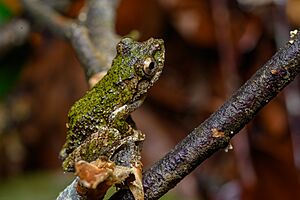Kurixalus bisacculus facts for kids
Quick facts for kids Kurixalus bisacculus |
|
|---|---|
 |
|
| Kurixalus bisacculus from Phu Kradueng National Park | |
| Conservation status | |
| Scientific classification | |
| Synonyms | |
|
Rhacophorus bisacculus Taylor, 1962 |
Kurixalus bisacculus is a small frog often called Taylor's tree frog. It belongs to the Rhacophoridae family, which includes many types of tree frogs. You can find this frog in parts of Southeast Asia and southern China. Scientists are still learning exactly where it lives because it can be confused with other similar frogs. However, we know it lives in countries like Thailand, Cambodia, Laos, Vietnam, and China.
What Does This Frog Look Like?
Male Kurixalus bisacculus frogs from Thailand are about 29–36 mm (1.1–1.4 in) long. This measurement is from their snout (nose) to their vent (bottom). Males from Cambodia are a bit smaller, around 27–31 mm (1.1–1.2 in) long. The female frogs are about 29 mm (1.1 in) long.
Their back, called the dorsum, is usually brown. It might have some darker spots or patterns. Their belly, or venter, is a light whitish or yellowish color. They have a large eardrum, which is called the tympanum. The frog's snout is pointed and has a small skin flap, especially in females.
Their fingers have small bits of webbing between them. Their toes are up to three-fourths webbed. The skin on their chin, belly, and the underside of their upper legs (femurs) feels bumpy. This bumpy texture is called granulate. The undersides of their arms and ankles (tarsi) have a row of small bumps, called tubercles. These bumps continue onto their outer fingers and toes.
Some Kurixalus bisacculus frogs from Hainan have an internal vocal sac. This is a part inside their body that helps them make sounds. However, frogs from Thailand have an external vocal sac, which is outside their body. Even with this difference, scientists believe they are the same species.
Where Does This Frog Live and Is It Safe?
Kurixalus bisacculus frogs live in places that are between 103 and 2000 meters (about 338 to 6,562 feet) above sea level. They can be found in plants or climbing in trees. They like scrubby areas, evergreen forests, and mixed bamboo forests. You might also see them at the edges of forests.
These frogs have also been seen on rubber and banana farms. However, scientists are not sure how well they can live in places where humans have changed the environment a lot.
The good news is that this frog is currently classified as "least concern" for extinction. This means scientists believe it has a large range, even if it has only been seen in a few specific spots. However, its home is still at risk. Threats include deforestation, which is when forests are cut down. Wildfires also threaten their habitat. In some parts of China, these frogs are collected.
Photos




